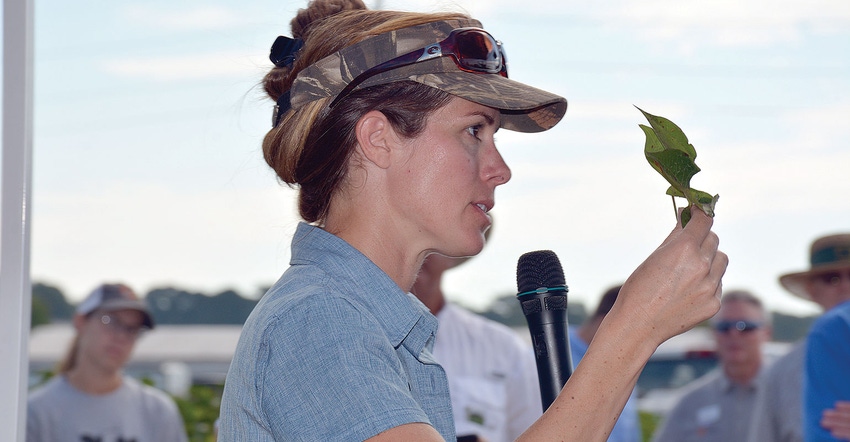
Looks can be deceiving.
Take target spot in cotton, for instance. Distinctive symptoms include irregular concentric lesions. That might not be definitive, however.
“Several other pathogens exhibit similar symptoms,” explains Heather Kelly, University of Tennessee plant pathologist. But target spot infection presents unique characteristics, as well, she said during a recent cotton field day at the West Tennessee Research and Education Center in Jackson, Tenn.
She says lesions expressed by several diseases may look similar, but producers should look at where those lesions originate and what time of the year they appear.
Kelly says target spot symptoms include:
Brown lesions that can reach 1 inch in diameter. Lesions can get larger than other leaf spots.
The lesions exhibit a series of concentric rings.
Lesions and defoliation start in the lower canopy. The only time it moves up is after it has already defoliated the lower canopy.
Symptoms usually appear after canopy closure.
Kelly says target spot is a disease of high-yielding cotton, typically occurring on good soils and during good growing conditions. Management options includes crop rotation, residue management and foliar fungicide applications.
Kelly also notes that target spot usually comes in late enough that it does not affect yield. “We did not see a lot this year, but a few farmers applied fungicides that prevented damage. Some applications went out that may not have needed to go out,” she says.
“We may see a response to fungicide application,” she adds, “but only about 15 percent of the time.”
Kelly says target spot incidence has been developing in Tennessee cotton since 2013 and exploded in 2016, when conditions were ideal for infection and development. She says frequent rainfall and cloudy skies that season did not allow cotton to dry out, creating a climate conducive to target spot development. Also, effect of target spot on yield has been correlated to the defoliation it causes, not the lesions, hence just seeing the lesions is not always cause for concern.
Look-Alikes
She presented posters showing other “look-alike” cotton diseases, with symptoms similar to target spot.
Leaf Spot Complex (Stemphillium, Alternaria, and Cercospora leaf spots)
Symptoms
Reddish to brown circular lesions throughout the canopy.
May exhibit concentric rings.
Lesions may become gray and dry, giving a “shot hole” appearance.
Opportunistic pathogens that are attacking stressed plants, usually nutrient deficient plants
“Symptoms usually appear in the upper canopy,” Kelly says. “Management options include proper soil fertility, especially potassium, and reduced plant stress.”
Nutritional deficiency, she adds, may make cotton more vulnerable, as do conditions that limit root growth and nutrient uptake.
Wet Weather Blight/Asochyta
Symptoms
Circular, light brown lesions, less than 0.1 inch, on cotyledons, leaves, stems and bolls.
Can appear target-like.
Disease develops in early season, but later if conditions are wet. Herbicide injury may mimic disease symptoms.
Kelly says producers should avoid planting cotton in cool, wet weather and should consider fungicide seed treatments. She also recommends managing residue.
Bacterial Blight (Angular leaf spot)
Symptoms
Lesions start as tiny, water-soaked spots that enlarge to dark brown, angular lesions, limited by leaf veins.
Lesions turn black as they expand, with water-soaking on the underside of the leaf.
Lesions can become “shot hole.”
Kelly says symptoms may appear at any stage and may cause defoliation.
“Last year, Bacterial blight showed target-like symptoms, but we also found more iconic symptoms. Where it develops is a crucial factor.”
Management options
Management options are limited to variety selection and residue management. “It can overwinter on debris. Complete resistant variety selection is the number one management option.”
Kelly says producers should be aware of the “disease triangle,” factors necessary for a disease to develop on a plant. The legs at the base of the pyramid represent the environment and the plant. At the apex is the pathogen. All three are necessary for a disease outbreak. The environment (including weather and field history), she says, must be favorable for the pathogen to infect a susceptible host plant.
She adds that timing — the host plant’s growth stage when the pathogen is present — may affect severity of the disease and if yield will be affected
Producers should look over the entire field, she adds, to assess disease development.
Kelly says variety selection should be the first step in managing cotton diseases and encourages growers to look at variety trials to determine which are resistant to specific pathogens.
About the Author(s)
You May Also Like






